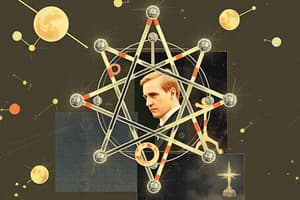Podcast
Questions and Answers
What is the primary characteristic of an exothermic reaction?
What is the primary characteristic of an exothermic reaction?
- It releases heat, causing temperature to rise. (correct)
- It absorbs heat, causing temperature to drop.
- It maintains a constant temperature throughout.
- It increases the kinetic energy of the reactants.
How is molar mass calculated?
How is molar mass calculated?
- Based on the number of moles in a solution.
- By adding the atomic masses of all elements in a compound. (correct)
- From the total mass of a substance divided by its volume.
- Using the density of a substance and its molecular formula.
What defines the equilibrium state in a chemical reaction?
What defines the equilibrium state in a chemical reaction?
- The reaction has completely proceeded to form products.
- Concentrations of reactants and products remain constant. (correct)
- The forward reaction occurs faster than the reverse reaction.
- Temperature and pressure conditions are unstable.
Which of the following best describes a hydrocarbon?
Which of the following best describes a hydrocarbon?
What is a primary goal of green chemistry?
What is a primary goal of green chemistry?
Which laboratory technique is primarily used for separating mixtures based on their affinities to different phases?
Which laboratory technique is primarily used for separating mixtures based on their affinities to different phases?
Which of the following statements about atoms is correct?
Which of the following statements about atoms is correct?
Which type of bond involves the transfer of electrons?
Which type of bond involves the transfer of electrons?
What is the mass number of an atom with 12 protons and 14 neutrons?
What is the mass number of an atom with 12 protons and 14 neutrons?
Which type of chemical reaction is represented by the equation AB → A + B?
Which type of chemical reaction is represented by the equation AB → A + B?
What defines the atomic number of an element?
What defines the atomic number of an element?
Which statement accurately describes acids?
Which statement accurately describes acids?
In the periodic table, what do groups or families represent?
In the periodic table, what do groups or families represent?
The pH scale is used to measure what property of a solution?
The pH scale is used to measure what property of a solution?
Flashcards are hidden until you start studying
Study Notes
Basic Concepts of Chemistry
- Matter: Anything with mass and volume, existing in three states: solid, liquid, gas.
- Atoms: Basic unit of matter, composed of protons, neutrons, and electrons.
- Elements: Pure substances made of only one type of atom (e.g., Hydrogen, Oxygen).
- Compounds: Substances formed from two or more elements chemically bonded (e.g., Water - H2O).
Atomic Structure
- Nucleus: Center of the atom containing protons (+) and neutrons (neutral).
- Electrons: Negatively charged particles orbiting the nucleus in energy levels.
- Atomic Number: Number of protons in an atom, defining the element.
- Mass Number: Total number of protons and neutrons in the nucleus.
Chemical Bonds
- Ionic Bonds: Formed by the transfer of electrons from one atom to another, resulting in charged ions.
- Covalent Bonds: Formed by sharing electrons between atoms, creating molecules.
- Metallic Bonds: Attraction between free-floating electrons and metal ions.
Chemical Reactions
- Reactants: Substances consumed in a reaction.
- Products: Substances formed in a reaction.
- Types of Reactions:
- Synthesis: A + B → AB
- Decomposition: AB → A + B
- Single Replacement: A + BC → AC + B
- Double Replacement: AB + CD → AD + CB
- Combustion: Hydrocarbon + O2 → CO2 + H2O
The Periodic Table
- Groups/Families: Vertical columns with similar chemical properties.
- Periods: Horizontal rows indicating increasing atomic number.
- Metals, Nonmetals, and Metalloids: Classifications based on properties.
Acids and Bases
- Acids: Substances that release H+ ions in solution (e.g., HCl).
- Bases: Substances that release OH- ions in solution (e.g., NaOH).
- pH Scale: Measures acidity (0-7) to neutrality (7) to alkalinity (7-14).
Stoichiometry
- Mole Concept: A quantity of substance containing Avogadro's number (6.022 x 10²³) of particles.
- Balanced Equations: Conservation of mass; same number of atoms of each element on both sides.
- Molar Mass: Mass of one mole of a substance, calculated from atomic masses.
Thermochemistry
- Exothermic Reaction: Releases heat, causing temperature to rise.
- Endothermic Reaction: Absorbs heat, causing temperature to drop.
- Enthalpy (ΔH): Heat content of a system, changes during reactions.
Kinetics and Equilibrium
- Reaction Rate: Speed at which reactants turn into products, influenced by concentration, temperature, and catalysts.
- Equilibrium: State where the forward and reverse reaction rates are equal, concentrations remain constant.
Organic Chemistry
- Hydrocarbons: Compounds composed only of carbon and hydrogen (e.g., alkanes, alkenes, alkynes).
- Functional Groups: Specific groups of atoms that determine the properties of organic compounds (e.g., -OH, -COOH).
Environmental Chemistry
- Green Chemistry: Design of chemical products/processes that reduce hazardous substances.
- Pollutants: Chemical substances that cause harm to the environment and living organisms.
Laboratory Techniques
- Titration: Method to determine concentration by reacting a solution with a standard solution.
- Chromatography: Technique for separating mixtures based on different affinities to stationary and mobile phases.
- Spectroscopy: Study of the interaction between matter and electromagnetic radiation to analyze substances.
Basic Concepts of Chemistry
- Matter includes anything that possesses mass and occupies space, existing as solid, liquid, or gas.
- Atoms are the fundamental units of matter, composed of three particles: protons (+), neutrons (neutral), and electrons (-).
- Elements are pure substances made entirely of one type of atom, such as Hydrogen (H) and Oxygen (O).
- Compounds are formed when two or more different elements chemically bond together, exemplified by Water (H2O).
Atomic Structure
- The nucleus of an atom contains protons and neutrons, serving as the core around which electrons orbit.
- Electrons are negatively charged and occupy distinct energy levels surrounding the nucleus.
- Atomic number is unique to each element, indicating the number of protons present in the atom.
- Mass number is the sum of protons and neutrons in the atomic nucleus.
Chemical Bonds
- Ionic bonds result from the transfer of electrons between atoms, producing charged ions that attract each other.
- Covalent bonds occur when atoms share electron pairs, allowing them to form molecules.
- Metallic bonds involve an attraction between positively charged metal ions and the delocalized electrons around them.
Chemical Reactions
- Reactants are the starting substances consumed during a chemical reaction.
- Products are the new substances formed as a result of the chemical reaction.
- Types of Reactions:
- Synthesis: Combination of two or more reactants to form a single product (A + B → AB).
- Decomposition: Breakdown of a single compound into simpler products (AB → A + B).
- Single Replacement: One element replaces another in a compound (A + BC → AC + B).
- Double Replacement: Exchange of components between two compounds (AB + CD → AD + CB).
- Combustion: Reaction of a hydrocarbon with oxygen, yielding carbon dioxide and water (Hydrocarbon + O2 → CO2 + H2O).
The Periodic Table
- Groups or families are vertical columns that contain elements with similar chemical behaviors.
- Periods are horizontal rows that reflect increasing atomic number from left to right.
- Elements are classified as metals, nonmetals, or metalloids based on their physical and chemical properties.
Acids and Bases
- Acids are substances that dissociate in solution to release hydrogen ions (H+), like hydrochloric acid (HCl).
- Bases produce hydroxide ions (OH-) in solution, such as sodium hydroxide (NaOH).
- The pH scale ranges from 0 (acidic), through 7 (neutral), to 14 (basic), measuring the acidity or alkalinity of solutions.
Stoichiometry
- The mole concept quantifies substance amounts, with one mole containing Avogadro's number of particles (6.022 x 10²³).
- Balanced equations uphold the law of conservation of mass, ensuring identical atom counts for each element on both sides.
- Molar mass represents the mass of one mole of a substance, derived from the atomic masses of its constituent elements.
Thermochemistry
- Exothermic reactions release heat, resulting in an increase in temperature in the surroundings.
- Endothermic reactions absorb heat, leading to a decrease in the temperature of their surroundings.
- Enthalpy (ΔH) refers to the heat content of a system and can change during chemical reactions.
Kinetics and Equilibrium
- Reaction rate measures how fast reactants convert to products, affected by factors such as concentration, temperature, and catalysts.
- Equilibrium is reached when the rates of the forward and reverse reactions become equal, resulting in constant concentrations of reactants and products.
Organic Chemistry
- Hydrocarbons are organic compounds that consist solely of carbon and hydrogen, classified into alkanes, alkenes, and alkynes.
- Functional groups are specific groups of atoms such as -OH (hydroxyl) or -COOH (carboxyl) that define the chemical properties of organic molecules.
Environmental Chemistry
- Green chemistry emphasizes the design of chemical products and processes that minimize the use and generation of hazardous substances.
- Pollutants are harmful chemical agents that negatively impact the environment and the health of living organisms.
Laboratory Techniques
- Titration is a method used to determine the concentration of a solution by reacting it with a standard solution.
- Chromatography separates components in a mixture based on their differing affinities toward stationary and mobile phases.
- Spectroscopy explores how matter interacts with electromagnetic radiation to analyze and characterize substances.
Studying That Suits You
Use AI to generate personalized quizzes and flashcards to suit your learning preferences.




